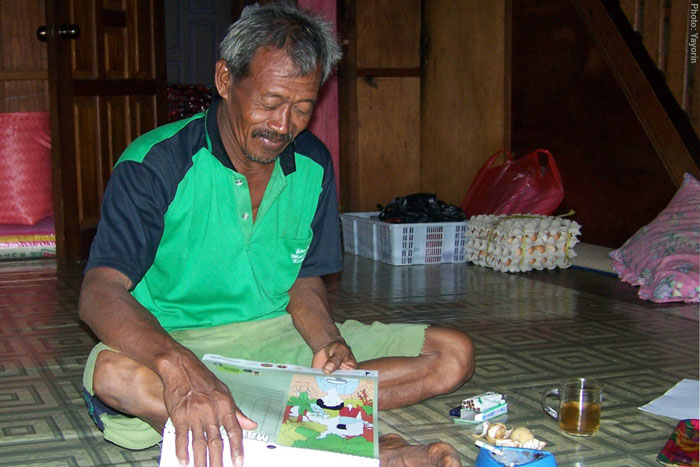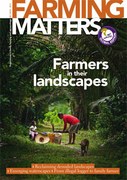Pak Usub used to make his living from working in forest industries, and put his hand to illegal logging in a protected forest reserve. However, realising that the trees would soon all be cut, he turned to farming to make a living. He and former logger friends developed new farming methods to overcome the constraints they faced. Now they earn a good living from farming and no longer need to cut trees from the forest.
The landscape of Lamandau area in Kotawaringin Barat District, in central Kalimantan, Indonesia, has undergone several changes over recent decades. Initially a natural freshwater swamp forest ecosystem, the area was changed into production forest with concessions granted to two timber companies. Then in 1998, a Minister of Forestry Decree changed the area by establishing the Lamandau Wildlife Reserve covering 76,000 hectares.
The reserve is exceedingly rich in biodiversity. Common animals include orangutans, gibbons, proboscis monkeys, bears, deer and hares, living in the forest dominated by ramin (Gonystylus bancanus), meranti (Shorea spp.), jejambu (Eugenia spp.), fir (Casuarina spp.), Ulin (Eusidexroxylon zwageri) and compass (Koompasia malaccensis). What makes it more special is that the reserve is where orangutans confiscated from illegal traders and private owners are released after being kept at the Orangutan Care Centre and Quarantine in Pangkalan Bun.
But when it was created, the reserve was seriously threatened by illegal loggers who would enter to cut the remaining ramin trees. Wild ramin grows only in freshwater swamp forest and due to illegal logging their numbers have declined sharply to the point where it is threatened with extinction.
The International Union for Conservation and Nature has put the species on its ‘red list’, but the beautiful timber is still highly sought after and can fetch US$1000 per cubic metre on the international market.
Whereas there is little hard data, it is certain that ramin timber and wood products are still being exported illegally, even though there is an official government ban on the export of ramin logs.
Mr Subeli, commonly called Pak Usub, used to harvest ramin logs in the buffer zone forest of Lamandau Wildlife Reserve. He and his family came to south Borneo around 1990, attracted by the lucrative ramin business, working first in sawmilling and processing industries which were mushrooming at that time. But in 2003, Pak Usub changed his mind. Based on daily observations, he began to realise that he could not depend on ramin forever, and that one day there would be no more trees left. He decided to start farming on the illegally logged-over land abundant around his village of Serumpun. He started to grow rice, and vegetables like Chinese green mustard and snake bean.
Settled farming was a totally new activity in the area, since local people used shifting agriculture, which was thought of as more productive and profitable than settled farming.
Pak Usub was looked upon by his neighbours as a foolish risk taker for cultivating rice. Being close to the sea, Serumpun was never considered as a suitable area, with salt water intrusion in the dry season and flash flooding in the rainy season as annual threats. To overcome this, Pak Usub and other former logger friends who also wanted to start family farming, experimented with new practices. Armed with his former experiences as a farmer in his hometown in south Kalimantan, he built dykes and dug trenches around his rice fields, connected to irrigation channels with sluice gates to regulate water flow. This protected the fields from sea water intrusion and flooding, and also helped the farmers to ‘harvest and save’ water when the tide was up in the Lamandau river.
They then planted mango orchards using the same method as for the rice and vegetable fields, with the harvest sold in to nearby villages. Following this success, Pak Usub and his friends also planted other fruit trees such as jackfruit, soursop, sapodilla, and star fruit. They also tried to grow the native jelutung (Dyera sp.), with Pak Usub saying, “these trees are for my children and grandchildren. They can tap the latex and sell it.” In addition, they had a huge success when they started breeding ducks, now having more than a thousand birds. All their soil fertility needs are met too from the compost they make by mixing crop residues with duck manure.
The work of these agriculture pioneers attracted the interest of local government, as their initiatives proved most able in supporting local livelihoods and thereby reducing forest encroachment. Akhmad Yadi, head of the Agriculture and Animal Husbandry Agency, said, “This is a good example of rice farming in tidal peat. With simple technology, they were able to keep the land from flooding or overflowing tides. Their harvest of six tonnes of dry grain per hectare is also a remarkable achievement.”
The success of Pak Usub and friends was not immediate, however. It required risk-taking, hard work and perseverance over the years, to overcome the many early setbacks. But gradually, they managed to regreen the landscape damaged by illegal logging. And besides that, the land is also more productive now. Family farming supports their livelihood, and with a stable income, Pak Usub and his friends no longer need to cut trees from the forest.
Janudianto and Subekti Rahayu (adapted and translated by Shintia D. Arwida)
Janudianto and Subekti Rahayu work for ICRAF. Shintia D. Arwida works for CIFOR, in Indonesia.
Email: s.rahayu@cgiar.org and s.arwida@cgiar.org


